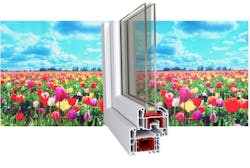Non-toxic quantum dots promise efficient LSC-based BIPV solar windows (and lighting)
******** See NOTE below this story for a related development ********
Los Alamos National Laboratory (LANL; Los Alamos, NM) has developed colorless, non-toxic quantum dots that enable solar windows—a type of building-integrated photovoltaic (BIPV) device packaged as a luminescent solar concentrator (LSC) or sunlight harvesting technology that can turn any window into a daytime power source.
RELATED ARTICLE: Small, stable quantum dots advance real-time neuronal research
"In these devices, a fraction of light transmitted through the window is absorbed by nanosized particles (semiconductor quantum dots) dispersed in a glass window, re-emitted at the infrared wavelength invisible to the human eye, and wave-guided to a solar cell at the edge of the window," said Victor Klimov, lead researcher on the project at the Department of Energy’s LANL. "Using this design, a nearly transparent window becomes an electrical generator, one that can power your room’s air conditioner on a hot day or a heater on a cold one."
These quantum dot LSCs are described in the journal Nature Nanotechnology in the study "Highly efficient large-area colourless luminescent solar concentrators using heavy-metal-free colloidal quantum dots" (DOI: 10.1038/NNANO.2015.178). The work was performed by researchers at the Center for Advanced Solar Photophysics (CASP) of Los Alamos, led by Klimov and the research team coordinated by Sergio Brovelli and Francesco Meinardi of the Department of Materials Science of the University of Milan-Bicocca (UNIMIB) in Italy.
In April 2014, using special composite quantum dots, the American-Italian collaboration demonstrated the first example of large-area luminescent solar concentrators free from reabsorption losses of the guided light by the nanoparticles. This represented a fundamental advancement with respect to the earlier technology, which was based on organic emitters that allowed for the realization of concentrators of only a few centimeters in size.
However, the quantum dots used in previous proof-of-principle devices were still unsuitable for real-world applications, as they were based on the toxic heavy metal cadmium and were capable of absorbing only a small portion of the solar light. This resulted in limited light-harvesting efficiency and strong yellow/red coloring of the concentrators, which complicated their application in residential environments.
Klimov, CASP's director, explained how the updated approach solves the coloring problem: "Our new devices use quantum dots of a complex composition which includes copper (Cu), indium (In), selenium (Se) and sulfur (S). This composition is often abbreviated as CISeS. Importantly, these particles do not contain any toxic metals that are typically present in previously demonstrated LSCs. Furthermore," Klimov noted, "the CISeS quantum dots provide a uniform coverage of the solar spectrum, thus adding only a neutral tint to a window without introducing any distortion to perceived colors. In addition, their near-infrared emission is invisible to a human eye, but at the same time is ideally suited for most common solar cells based on silicon."
Hunter McDaniel, formerly a Los Alamos CASP postdoctoral fellow and presently a quantum dot entrepreneur (UbiQD founder and president), added, "With a new class of low-cost, low-hazard quantum dots composed of CISeS, we have overcome some of the biggest roadblocks to commercial deployment of this technology. One of the remaining problems to tackle is reducing cost, but already this material is significantly less expensive to manufacture than alternative quantum dots used in previous LSC demonstrations," McDaniel added.
A key element of this work is a procedure comparable to the cell casting industrial method used for fabricating high optical quality polymer windows. It involves a new UNIMIB protocol for encapsulating quantum dots into a high-optical quality transparent polymer matrix. The polymer used in this study is a cross-linked polylaurylmethacrylate, which belongs to the family of acrylate polymers. Its long side-chains prevent agglomeration of the quantum dots and provide them with the "friendly" local environment, which is similar to that of the original colloidal suspension. This allows one to preserve light emission properties of the quantum dots upon encapsulation into the polymer.
Sergio Brovelli, the lead researcher on the Italian team, concluded," Quantum dot solar window technology, of which we had demonstrated the feasibility just one year ago, now becomes a reality that can be transferred to the industry in the short to medium term, allowing us to convert not only rooftops, as we do now, but the whole body of urban buildings, including windows, into solar energy generators."
SOURCE: LANL; https://www.lanl.gov/news-archive/news-releases/2015/August/08.24-capture-sunlight-with-window.php
********
NOTE: In a related press release from Oregon State University (see http://oregonstate.edu/ua/ncs/archives/2015/aug/%E2%80%9Cquantum-dot%E2%80%9D-technology-may-help-light-future), copper indium diselenide quantum dots are being fabricated using a "continuous flow" chemical reactor and microwave heating technology that's conceptually similar to the ovens that are part of almost every modern kitchen. "We may finally be able to produce low cost, energy efficient LED lighting with the soft quality of white light that people really want," said Greg Herman, an associate professor and chemical engineer in the OSU College of Engineering. “At the same time, this technology will use nontoxic materials and dramatically reduce the waste of the materials that are used, which translates to lower cost and environmental protection."
********
About the Author

Gail Overton
Senior Editor (2004-2020)
Gail has more than 30 years of engineering, marketing, product management, and editorial experience in the photonics and optical communications industry. Before joining the staff at Laser Focus World in 2004, she held many product management and product marketing roles in the fiber-optics industry, most notably at Hughes (El Segundo, CA), GTE Labs (Waltham, MA), Corning (Corning, NY), Photon Kinetics (Beaverton, OR), and Newport Corporation (Irvine, CA). During her marketing career, Gail published articles in WDM Solutions and Sensors magazine and traveled internationally to conduct product and sales training. Gail received her BS degree in physics, with an emphasis in optics, from San Diego State University in San Diego, CA in May 1986.
